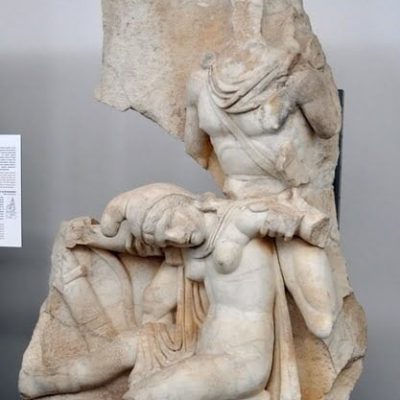Chapters
In 58 CE there was a rivalry between the Romans and the Parthians for influence in Armenia. As a result, the Roman-Parthian war broke out (58-63 CE).
Background of events
In the east, Rome’s main enemy was invariably the Parthia, which, like Rome, tried to maintain its influence in the client state of Armenia. Under the agreement of Octavian Augustus and the Parthian ruler Phraates IV, the Romans had the right to nominate and crown rulers on the throne of Armenia. However, in 54 CE king Vologazes I of the Parthia, taking advantage of the internal crisis in Armenia and the change on the Roman throne, made his brother Tiridates I the ruler of the puppet state. Then the situation in the east got inflamed.
In the east, apart from Corbulo (he had the III Gallica and VI Ferrata legions under him), also commanded the governor of the Syria province – Gaius Durmius Ummidius Quadratus – who had two legions under their control: X Fretensis and XII Fulminata.
At the request of both commanders, the Parthian king handed over prisoners of war to the Romans. Thus, the war was postponed, which in turn was used by the Romans to strengthen their forces. In addition, there was a not entirely clear conflict between Corbulo and Ummidius – probably about which of them is to take the prisoners.
Outbreak of war
In 56 CE to the east came the legion IIII Scythia from the Danube. Corbulo undertook to improve morale and discipline in the Roman ranks and strenuous training. In 58 CE the army of the king of Armenia, Tiridates, attacked the unprepared Roman army. With subsequent clashes, the Romans were dragged deep into Armenia. In the meantime, the Caucasus tribes fought against the Armenians, which gave the legions III Gallica, VI Ferrata and X Fretensis a chance to start a siege of Artaxata (now Yerevan) – one of the capitals of Armenia. At the same time, the Hircan revolt broke out against the Parthian rule. It is possible that the coincidence was not accidental and the Romans deliberately encouraged the rebellion. Faced with such a situation, Parthian King Vologazes could not help his brother and Artaxata was conquered by the Romans.
In 59 CE, the Romans crossed the hot deserts of Mesopotamia and the Tigris and headed for Tigranocerta, Armenia’s second capital. The city surrendered before the siege took place, and Nero was able to proclaim his complete success. Tigranes, a faithful servant of the Romans, was placed on the throne of Armenia. Tigranes spent a long time in Rome as a royal hostage, which resulted in the development of a far-reaching submission in Tigranes, which the Roman historian Tacitus compared to that of a slave.
The Romans realized that this was not the end of the struggle for Armenia and gradually strengthened their forces in the region, including Tigranes VI was given a garrison of 1,000 legionaries, three auxiliary cohorts and two cavalry units. Moreover, in 61 CE the V Macedonica legion appeared in Armenia. The same year, Vologazes suppressed the Hircan rebellion and proclaimed his brother Tiridates king of Armenia, while Tigranes, on the orders of the Romans, invaded Adiabene – a kingdom subordinated to the Parthians and ruled by Monobazes II. The Parthians considered this a violation of peace terms and attacked Armenia.
In the spring of 62 CE, there was another war. The Parthians set out to lay siege to Tigranocerta. The Romans planned to trap the Parthian troops between their two armies and annihilate them completely; however, the incompetence of the commanders meant that there was only a temporary truce and the postponement of the siege of the capital of Armenia.
In the summer of the same year, Lucius Caesenius Petus, the Roman commander and governor of Cappadocia, who also served as the consulate of the previous year, appeared in the region. He had the legions V Macedonica, IIII Scythica and XII Fulminata under his command, where he set off for Armenia with the last two.
Nero subordinates Armenia.At the same time, Corbulo crossed the Euphrates and entered Mesopotamia. It was then that the news of the defeat of Petus, who had fallen into a trap set by the Parthians at Arsamosata, found him. Petus – judged to be an incompetent commander – surrendered to Rhandea and pledged that Armenia would be returned to Tiridates. He took the throne in 63 CE.
Then Korbulon took over command of the legions (III Gallica, V Macedonica, VI Ferrata and the newly formed XV Apollinaris). In 63 CE, at the head of a large army, he crossed the Euphrates. The Parthian king, fearing a skirmish with the Romans, decided for peace. On the side of the Romans, the treaty was negotiated by the Egyptian Jew – Tiberius Julius Alexander. Under it, the Romans undertook not to fight any further, and the Parthians to refrain from any claims for the throne of Armenia. Tiridates could receive the crown of Armenia only with the consent of Nero.
Great success
The victory was welcomed in Rome with great cheers, and Nero bestowed great honours on Corbulo. Moreover, the gates of the Temple of Janus were closed as a sign of the coming of peace. It is worth noting that Corbulo was said to have written memoirs from the expeditions to the east. The work, however, has not survived to our times.
Despite the great merits to his motherland, Corbulo met a sad fate. Adored by crowds and suspected (wrongly) by Nero of taking part in the plot, he was forced to commit suicide. Corbulo lunged at the sword as ordered.










